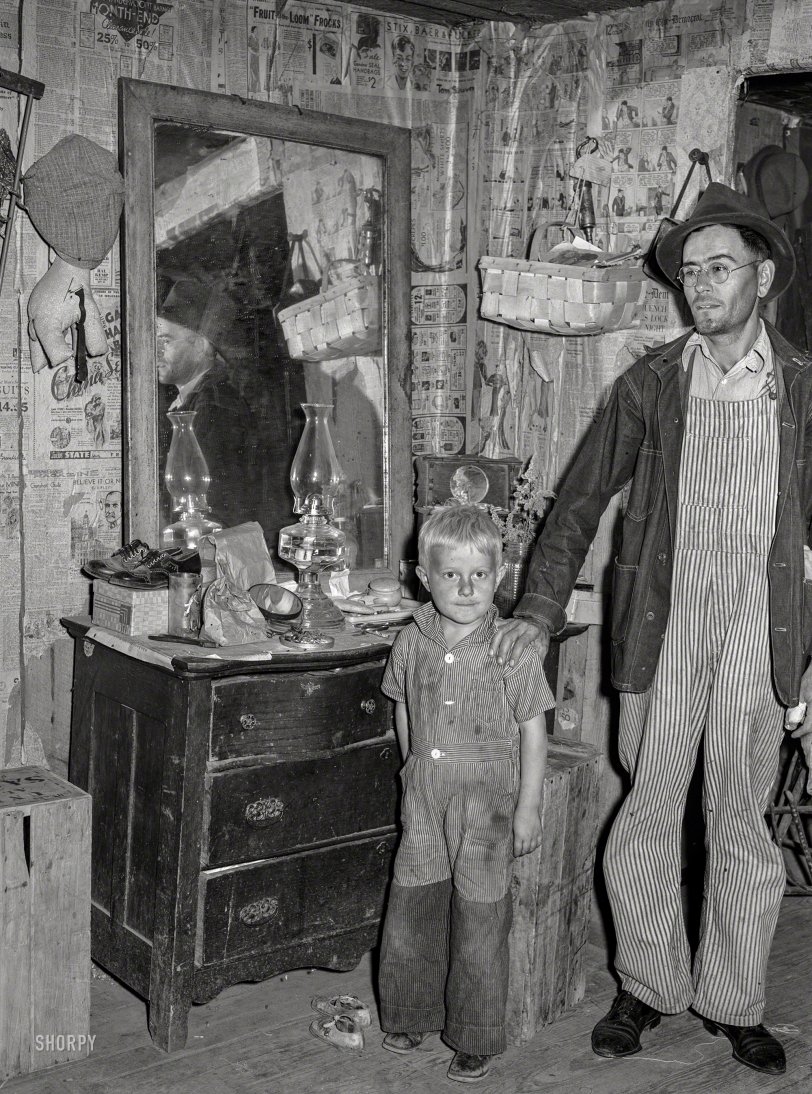


Framed or unframed, desk size to sofa size, printed by us in Arizona and Alabama since 2007. Explore now.
Shorpy is funded by you. Patreon contributors get an ad-free experience.
Learn more.

- Freeze Frame
- Texas Flyer wanted
- Just a Year Too Soon
- WWII -- Replacing men with women at the railroad crossing.
- Yes, Icing
- You kids drive me nuts!
- NOT An Easy Job
- I wonder
- Just add window boxes
- Icing Platform?
- Indiana Harbor Belt abides
- Freezing haze
- Corrections (for those who care)
- C&NW at Nelson
- Fallen Flags
- A dangerous job made worse
- Water Stop
- Passenger trains have right of way over freights?
- Coal
- Never ceases to amaze me.
- Still chuggin' (in model form)
- Great shot
- Westerly Breeze
- For the men, a trapeze
- Tickled
- Sense of loneliness ...
- 2 cents
- Charm City
- What an Outrage
- Brighton Park
Print Emporium
And a Little Child: 1939

November 1939. "Former tiff miner, now blind, with son. Washington County, Missouri. Photographs show mining and miners of tiff, form of white lead used in paint. A dangerous occupation because tiff mines are never timbered and all mining is done by hand labor from crude holes in ground usually 10 to 15 feet deep." Photo by Arthur Rothstein, Farm Security Administration. View full size.
Tiff is Barium Ore, not Lead
I wasn't familiar with the term "tiff" until I saw this photo caption, but research indicates it refers to barite or barium sulfate ore. There were a lot of barite deposits in the area - in fact if you look at old topo maps you can see small mines all over the place, some of which are lead, and some barite.
Fortunately barium sulfate is not nearly as toxic as lead ores, so we don't have to feel quite so sorry for the poor lad in the picture. Although he may be lead-poisoned anyway, just from living around the mines and smelters.
[Trachoma, a bacterial infection, was the cause of blindness among Missouri's miners of tiff, a substitute for white lead in paint. - Dave]
4 year old paper
The Ripley's Believe it or Not cartoon that can be seen to the left of the mirror next to the shoes was published in the Aug 29, 1935 edition of the St. Louis Post-Dispatch, making the paper lining the walls over 4 years old. Items it covered included John G. Zook who recopies the items he wrote 50 years ago for the same newspaper, a clothespin used for 62 consecutive years by Mrs. Mary Richmond, the Mormon Nauvoo Temple, and Eddie Cole of Galveston who pitched a perfect game of baseball.
Lead Mining in S.E. Missouri
Lead was a huge industry in S.E. Missouri, producing about 1/3 of the lead mined in the U.S. at any given time. The ore was found in a couple of large areas within about 60 miles south and west of St. Louis. Washington County was in the upper left corner of the "lead belt" region.
There is film of tiff mining by hand in this area, probably from the 1930s and difficult to watch, showing how it was done and also some of social problems that accompanied it: https://www.youtube.com/watch?v=tU7Ovb5NtaI
This video from 1948 is about hard-rock mining in the Missouri lead belt and gives a lot more information about where the ores were found and how the more common types (e.g., galena) were mined and processed: https://www.youtube.com/watch?v=6HhdkkdsvTM
Some are survivors, some have disappeared
There used to be quite a lot of iron, lead, and zinc mines in southern Missouri. Lead is still mined today in Washington County and surrounding counties. The Missouri School of Mines was founded in 1870 in Rolla (about 50 miles west of this photo), to train engineers for the mines. It later became part of the University of Missouri system.
The walls are covered with pages of the St. Louis Post-Dispatch and St. Louis Globe-Democrat, which would have been the closest "big city" papers. The Post-Dispatch is still around, but the Globe-Democrat ceased publishing in 1986.
At the top right of the mirror is an ad for the Stix, Baer, and Fuller department store in St. Louis. Stix expanded to Kansas City and I remember going there with Mom when I was young. It was eventually sold to Dillard's, and then Macy's.
Tiff is also still mined today, but the process is much different than it was in 1939. One large deposit of it is near the Virginia-Maryland border and is owned by the federal government. The feds extract the tiff and supply it to private processors, who must use automated equipment to handle it - no manual processing. This equipment compresses the tiff into a more compact form that is easier to ship and to use for further processing.
























On Shorpy:
Today’s Top 5